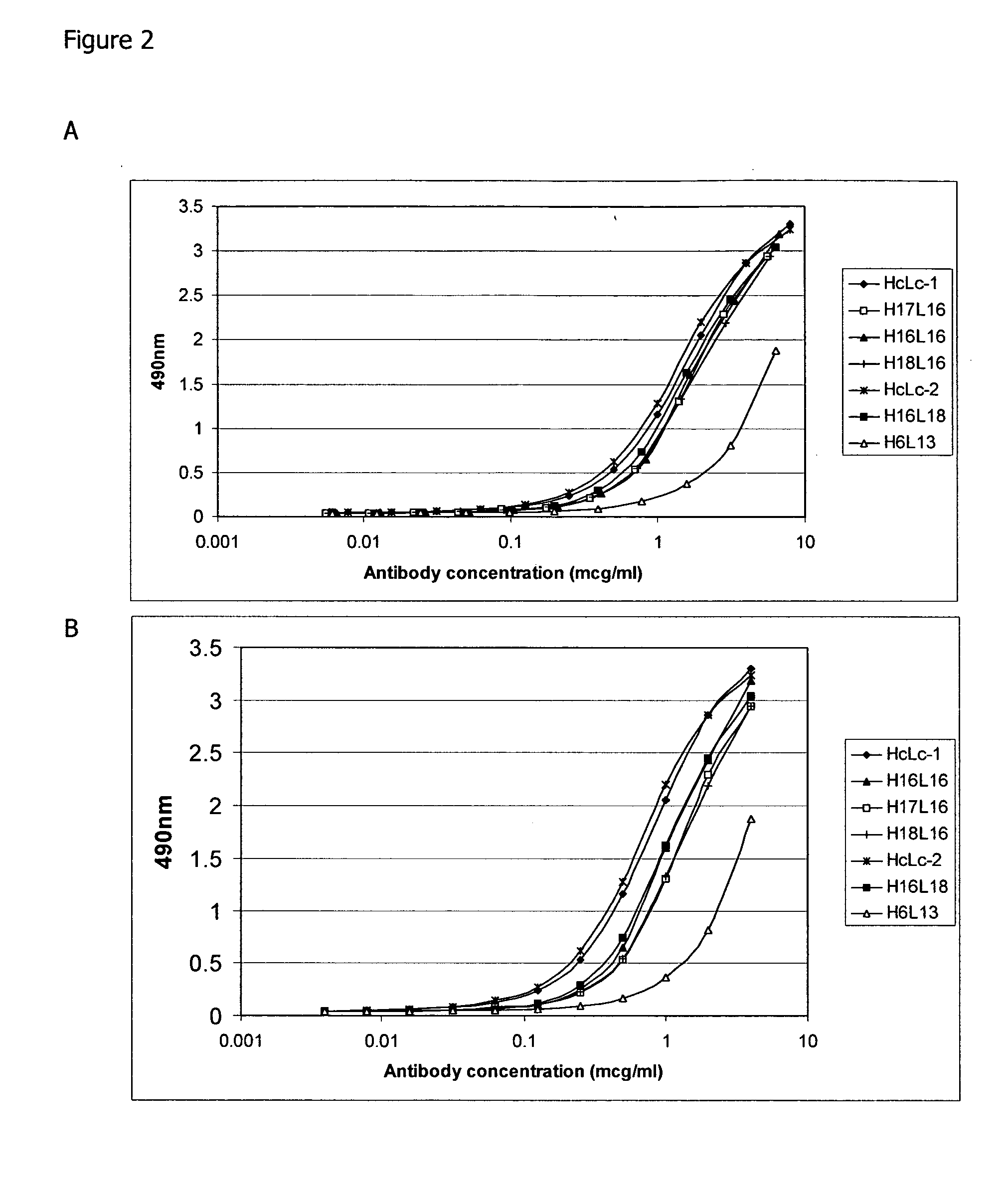Immunoglobulins
a technology of immunoglobulins and immunoglobulins, which is applied in the field of immunoglobulins, can solve the problems of drug composition, dose-limiting side effects, and failure to achieve clinical trials, and achieve the effects of inhibiting neurodegeneration, promoting functional recovery, and inhibiting neurodegeneration
- Summary
- Abstract
- Description
- Claims
- Application Information
AI Technical Summary
Benefits of technology
Problems solved by technology
Method used
Image
Examples
example 1
Construction and Expression of Humanised Anti-NOGO Antibodies
[0151] Murine and Humanised VH and VL constructs were prepared de novo by build up of overlapping oligonucleotides including restriction sites for cloning into Rld and Rln mammalian expression vectors as well as a human signal sequence. Hind III and Spe I restriction sites were introduced to frame the VH domain containing the CAM PATH-1H signal sequence for cloning into Rld containing the human γ1 mutated constant region. Hind III and BsiWI restriction sites were introduced to frame the VL domain containing the CAM PATH-1H signal sequence for cloning into Rln containing the human kappa constant region. CAMPATH-1H signal sequence: MGWSCIILFLVATATGVHS (SEQ.I.D.NO:82)
[0152] In parallel a chimeric version of 11C7 was generated (see WO04 / 052932). The variable heavy domain sequence (derived from WO04 / 052932 Seq ID 43) and variable light domain sequence (derived from WO04 / 052932 Seq ID 44) were prepared de novo by build up of o...
example 2
Antibody Expression in CHO Cells
[0153] Rld and Rln plasmids encoding the heavy and light chains respectively were transiently co-transfected into CHO cells and expressed at small scale or large scale to produce antibody. Alternatively the same plasmids were co-transfected into CHO cells by electroporation and a stable polyclonal population of cells expressing the appropriate antibody were selected using a nucleoside-free media. Recombinant antibody was recovered and purified by affinity chromatography on Protein A sepharose.
example 3
Humanised Anti-NOGO Antibody Binds to NOGO
[0154] GST-human NOGO-A56 (SEQ ID: 76) at 1 μg / ml in PBS was coated onto Nunc Immunosorp plates (100 μl per well) at 4° C. overnight. Wells were rinsed once with TBS+0.05% Tween (TBST) then incubated with 2% BSA in TBST to block non-specific binding sites at room temperature for 1 hour. Antibodies were diluted in TBST+2% BSA to 10 μg / ml and 1 / 2 dilutions made from this. Antibodies were added to wells in duplicate and incubated at room temperature for 1 hour. Wells were washed three times with TBST then incubated with anti-human kappa peroxidase conjugate (1:2000) for 1 hour. The wells were washed three times with TBST and then incubated with 100 μl OPD peroxidase substrate (Sigma) per well for 10 minutes. The colour reaction was stopped by the addition of 25 μl concentrated H2SO4. Optical density at 490 nm was measured using a plate reader. Background values read from wells with no antibody were subtracted.
[0155]FIGS. 1-5 illustrate the do...
PUM
| Property | Measurement | Unit |
|---|---|---|
| temperature | aaaaa | aaaaa |
| pH | aaaaa | aaaaa |
| concentration | aaaaa | aaaaa |
Abstract
Description
Claims
Application Information
 Login to View More
Login to View More - R&D
- Intellectual Property
- Life Sciences
- Materials
- Tech Scout
- Unparalleled Data Quality
- Higher Quality Content
- 60% Fewer Hallucinations
Browse by: Latest US Patents, China's latest patents, Technical Efficacy Thesaurus, Application Domain, Technology Topic, Popular Technical Reports.
© 2025 PatSnap. All rights reserved.Legal|Privacy policy|Modern Slavery Act Transparency Statement|Sitemap|About US| Contact US: help@patsnap.com



